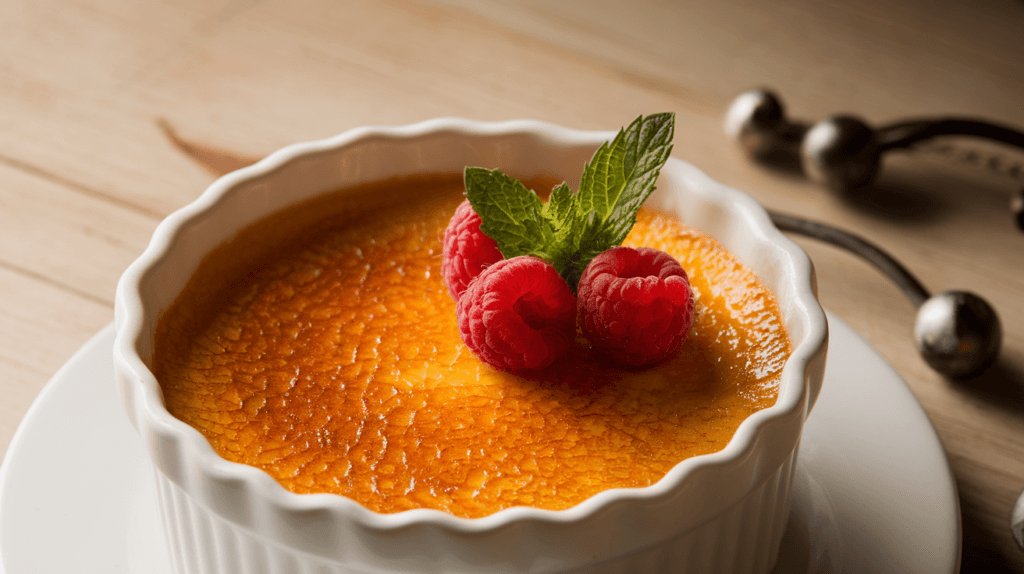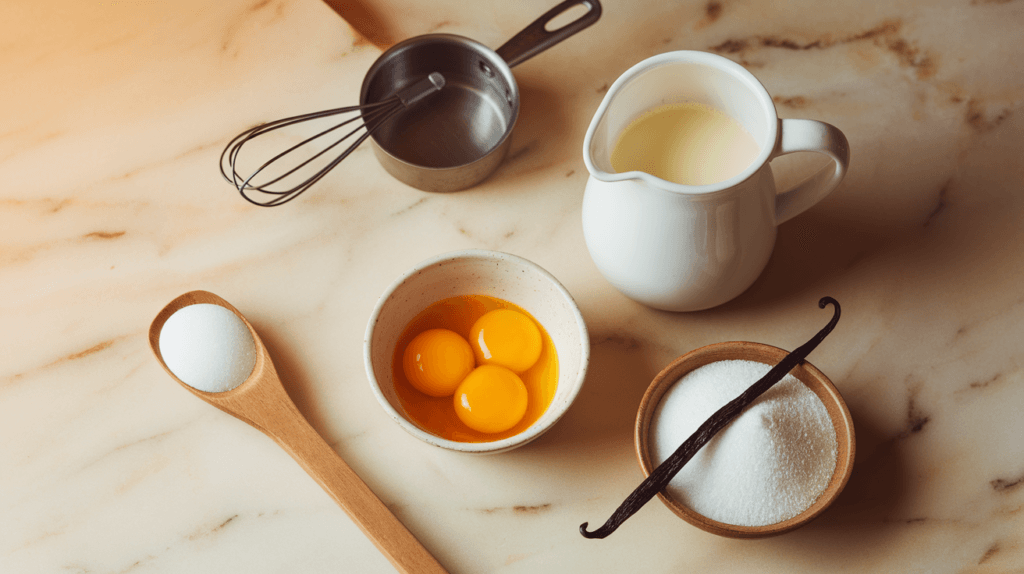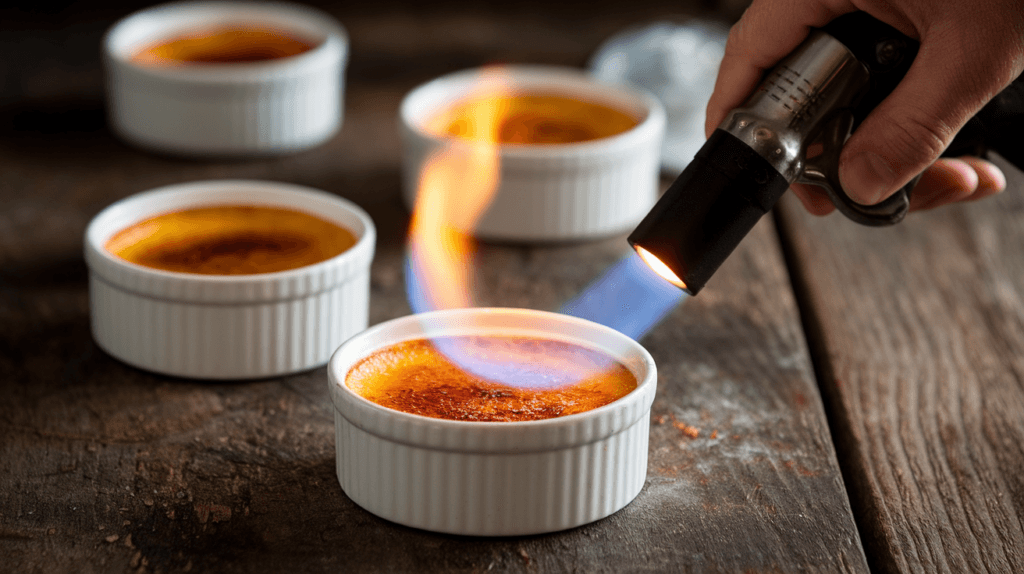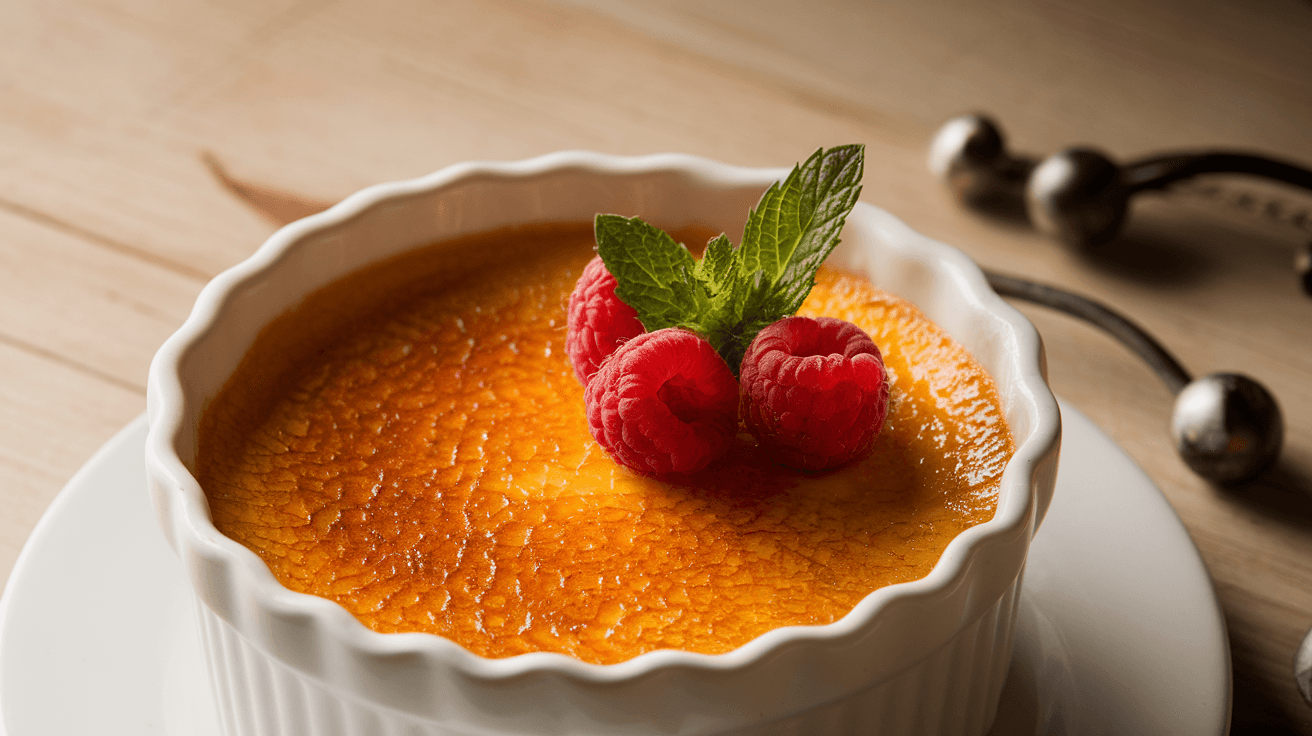Introduction: What is the Secret to Crème Brûlée?

Crème brûlée, with its velvety custard base and delicate caramelized sugar topping, has captured the hearts and palates of dessert lovers worldwide. Known for its luxurious simplicity, this French classic is a hallmark of fine dining and culinary artistry. But what is the secret to crème brûlée that makes it so iconic? This article reveals everything you need to know.
The phrase “crème brûlée” translates to “burnt cream,” a nod to its signature crisp caramelized top layer. Breaking through this delicate shell to reveal the creamy interior is a sensory delight that makes crème brûlée unforgettable. But what is the secret to crème brûlée that creates this perfect balance? But what truly makes this dessert stand out? Is it the perfect balance of texture? The use of premium ingredients? Or the skilled technique required to achieve its iconic finish?
In this article, we will explore the secrets behind crème brûlée—its origins, science, and the artistry that goes into creating the ultimate dessert experience. From mastering the custard to achieving the perfect brûlée topping, we’ll uncover everything you need to know to elevate your crème brûlée game.
Discovering What is the Secret to Crème Brûlée: A Classic Icon
Origins of Crème Brûlée
The origins of crème brûlée are shrouded in mystery, leading many to wonder, what is the secret to crème brûlée that has made it so universally cherished? France, England, and Spain each have their own version of custard-based dishes with caramelized tops, making it challenging to pinpoint the true birthplace of crème brûlée.
- French Influence: In France, the first recorded mention of crème brûlée appeared in François Massialot’s 1691 cookbook, Le Cuisinier Royal et Bourgeois. The recipe described a rich custard topped with a layer of sugar, which was caramelized with a red-hot iron. This method laid the groundwork for the modern-day preparation of crème brûlée.
- English Claim: In England, a similar dessert called “Trinity Cream” was famously associated with Trinity College, Cambridge. This version of the dessert featured the college’s crest imprinted on the sugar crust before it was caramelized.
- Spanish Contribution: Spain also has a stake in the custard dessert debate with crema catalana, a dish often compared to crème brûlée. Unlike its French counterpart, crema catalana uses milk instead of cream and is flavored with citrus and cinnamon.
Despite its debated origins, crème brûlée became a signature dessert in French cuisine, celebrated for its refined simplicity and elegant presentation.
Evolution Over the Centuries
Crème brûlée has evolved from a dish enjoyed by the elite to a universally beloved dessert. But what is the secret to crème brûlée that allowed it to stand the test of time? Its combination of simplicity, versatility, and indulgence has made it a staple on menus worldwide. The introduction of the culinary blowtorch revolutionized its preparation, making it easier to achieve the perfect caramelized topping.
Today, crème brûlée graces the menus of fine-dining establishments worldwide, often served as a symbol of culinary sophistication. Its rich history adds to its allure, connecting each bite to centuries of gastronomic tradition.
Crème Brûlée in Modern Cuisine
Modern chefs continue to innovate with crème brûlée, introducing flavors like matcha, lavender, and salted caramel to keep the dessert contemporary and exciting. Some restaurants even experiment with savory versions, incorporating ingredients like truffle or cheese.
The enduring appeal of crème brûlée lies in its versatility. Whether served in its classic form or with a creative twist, it remains a timeless dessert that celebrates the art of cooking.
What is the Secret to Crème Brûlée? Key Ingredients Explained
The success of crème brûlée depends heavily on the quality and balance of its ingredients. Though the recipe may seem simple, each component plays a crucial role in achieving the dish’s signature creamy texture and caramelized topping. Let’s break down these essential ingredients and explore why they are so vital.

1. Heavy Cream: The Creamy Foundation
Heavy cream is the backbone of crème brûlée, providing its smooth and luxurious texture. When exploring what is the secret to crème brûlée, the use of fresh and high-quality heavy cream is essential. For those asking, what is the secret to crème brûlée, it starts with the quality of ingredients like heavy cream.
- Why It’s Important: The high fat content in heavy cream ensures a velvety consistency that melts in your mouth. Substituting with lighter creams or milk may result in a thinner and less decadent custard.
- Tips for Success: Use fresh, high-quality cream for the best results. For added flavor, infuse the cream with ingredients like vanilla pods, coffee beans, or citrus zest during the heating process.
2. Egg Yolks: The Custard’s Structure
Egg yolks act as the primary thickening agent in crème brûlée, giving it body and richness.
- Why They Matter: The proteins in the yolks coagulate during baking, transforming the liquid mixture into a firm yet creamy custard.
- The Secret to Perfection: The eggs must be tempered carefully to prevent curdling. This involves gradually adding the warm cream to the yolks while whisking constantly.
3. Sugar: Sweetness and Caramelization
Sugar is a dual-purpose ingredient in crème brûlée, providing both sweetness and the iconic caramelized crust.
- For the Custard: Granulated sugar is whisked into the egg yolks to sweeten the base. The amount of sugar can be adjusted to suit personal taste preferences.
- For the Topping: A fine layer of sugar is sprinkled on the surface of the chilled custard. When heated, the sugar melts and forms a brittle, glass-like crust.
- Pro Tip: Use superfine sugar for the topping to ensure even caramelization and avoid burning.
4. Vanilla: The Quintessential Flavor
Vanilla is the hallmark flavor of classic crème brûlée. It infuses the custard with a delicate, aromatic sweetness.
- The Best Option: Real vanilla beans are ideal for authentic flavor. Simply split the bean, scrape out the seeds, and add them to the cream as it heats.
- Alternatives: Vanilla extract or paste can be used if whole beans are unavailable, but they may lack the same depth of flavor.
5. Optional Ingredients for Variations
While the classic version focuses on these four main ingredients, modern adaptations often include additional flavors:
- Chocolate or Coffee: Add melted chocolate or espresso to the custard for a bold twist.
- Fruits: Purees of berries, mango, or passionfruit can be swirled into the base for a fruity variation.
- Spices: Cardamom, cinnamon, or nutmeg can elevate the flavor profile and add warmth.
The Importance of Ingredient Quality
The simplicity of crème brûlée leaves no room for error when it comes to ingredient quality. Here’s why:
- Fresh Dairy: Fresh cream and eggs ensure a rich and pure flavor.
- Real Vanilla: Synthetic vanilla can’t replicate the nuanced taste of real vanilla beans.
- Fine Sugar: Ensures smooth custard and an even brûlée.
By focusing on premium ingredients and understanding their roles, you’re one step closer to mastering the art of crème brûlée.
The Science Behind What is the Secret to Crème Brûlée
Crème brûlée is more than just a dessert—it’s a delicate interplay of chemistry and culinary technique. Understanding the science behind its preparation will help you master its creamy texture and crisp topping.
1. Custard Creation: The Magic of Protein Coagulation
The heart of crème brûlée lies in its custard, which is created through the coagulation of proteins in the egg yolks.
- How It Works: When heated gently, the proteins in the egg yolks unravel and form a network that traps the cream and sugar, transforming the liquid mixture into a smooth and set custard.
- The Ideal Temperature: The custard should be baked at a low and steady temperature (around 160°C or 325°F) to prevent the proteins from overcoagulating, which could result in a grainy or curdled texture.
Pro Tip: Always use a water bath (bain-marie) during baking to evenly distribute heat and avoid overheating the custard edges.
2. The Role of Sugar in Custard Stability
Sugar isn’t just for sweetness; it also stabilizes the custard by interfering with protein coagulation.
- How It Helps: Sugar slows down the coagulation process, allowing the custard to set gradually and achieve its creamy consistency.
- Balancing Sweetness: Be mindful of the sugar-to-cream ratio. Too much sugar can overpower the flavor, while too little can compromise the custard’s structure.
3. Achieving the Perfect Brûlée: Caramelization Science
The brûlée, or “burnt” topping, is created through caramelization, a complex chemical process where sugar melts and browns under high heat. This technique is often the answer to what is the secret to crème brûlée and why its textures are so perfectly balanced.
- What Happens: At temperatures above 150°C (302°F), sugar molecules break down and recombine, creating new compounds that give the topping its characteristic color, flavor, and aroma.
- Achieving Even Caramelization: Use a culinary blowtorch or broiler to melt and brown the sugar evenly. Rotate the ramekin as you apply heat to avoid burning spots.
Pro Tip: Allow the custard to chill completely before adding the sugar topping. If the custard is warm, the heat from the caramelization process may soften it.
4. Balancing Textures: Creamy vs. Crispy
The appeal of crème brûlée lies in the contrast between its silky custard and crunchy caramelized sugar.
- The Key to Creaminess: Proper baking and high-fat cream ensure a custard that’s soft and velvety.
- The Key to Crispiness: A thin, even layer of sugar is essential for a crackable brûlée. Using too much sugar can result in a thick, overly hard crust.
5. Troubleshooting Common Scientific Issues
| Problem | Cause | Solution |
|---|---|---|
| Curdled Custard | Overcooked or overheated eggs | Bake at a lower temperature and use a water bath. |
| Cracked Custard | Rapid cooling or overbaking | Allow custard to cool slowly after baking. |
| Burnt Sugar | Blowtorch held too close | Keep the torch moving and maintain a safe distance. |
| Sticky Sugar Layer | Humidity or under-caramelization | Ensure thorough caramelization and avoid refrigeration after brûlée. |
The Science of Infusion: Flavor Development
Infusing the cream with flavors (like vanilla beans, coffee, or citrus) is another scientific process that enhances the dessert.
- How It Works: Heat helps release the volatile compounds in the flavoring agents, allowing them to disperse into the cream. The longer the infusion, the more pronounced the flavor.
- Pro Tip: Strain the infused cream to remove any solids and ensure a smooth custard.
Mastering the science behind crème brûlée transforms this dessert from intimidating to approachable. With a little attention to detail and an understanding of these chemical processes, you can consistently achieve perfection.
Essential Techniques: What is the Secret to Crème Brûlée Success?
Creating the perfect crème brûlée requires precision, patience, and attention to detail. While the recipe is simple at its core, mastering the techniques ensures a dessert that’s both visually stunning and delicious. Below are the essential steps and expert tips to achieve flawless results every time.
1. Tempering the Egg Yolks: The Cornerstone of Custard
Tempering is the process of slowly combining hot cream with egg yolks to prevent them from cooking unevenly or curdling.
- Why It’s Crucial: Pouring hot cream too quickly can scramble the eggs, ruining the custard’s texture.
- How to Do It:
- Whisk the egg yolks and sugar together until slightly thickened.
- Gradually add a small amount of the hot cream (about ¼ cup) while whisking constantly.
- Continue adding the cream in small increments until fully combined.
Pro Tip: Strain the mixture through a fine sieve before pouring it into ramekins to remove any lumps or egg solids.
2. The Water Bath (Bain-Marie): A Gentle Baking Method
Using a water bath is essential to evenly cook the custard without overcooking the edges or causing cracks.
- How to Set It Up:
- Place the ramekins in a deep baking dish or roasting pan.
- Fill the pan with hot water until it reaches about halfway up the sides of the ramekins.
- Carefully transfer the pan to the oven to avoid splashing water into the custard.
- Why It Works: The water bath moderates the oven’s heat, ensuring the custard sets gently and uniformly.
Pro Tip: Cover the baking dish loosely with aluminum foil to prevent the tops of the custard from browning.
3. Checking for Doneness: The Jiggle Test
Knowing when to remove your crème brûlée from the oven is key to achieving the perfect texture.
- The Jiggle Test: Gently shake the ramekins. The custard should be set around the edges but still have a slight wobble in the center.
- Avoid Overbaking: Overcooked custard will have a dense, rubbery texture. The residual heat will continue to set the custard as it cools.
4. Cooling and Chilling: Locking in the Texture
Once baked, crème brûlée must be cooled and chilled to achieve its signature creamy consistency.
- Cooling: Let the ramekins cool to room temperature before refrigerating.
- Chilling: Cover the ramekins with plastic wrap and refrigerate for at least 4 hours or overnight. This step allows the flavors to meld and the custard to firm up.
Pro Tip: Avoid adding the sugar topping until just before serving to maintain the crispness of the brûlée.
5. Caramelizing the Sugar Topping: The Art of the Brûlée

The brûlée, or caramelized sugar layer, is what transforms custard into crème brûlée.
- How to Create It:
- Sprinkle an even, thin layer of sugar over the chilled custard.
- Use a culinary blowtorch to melt and caramelize the sugar, keeping the flame moving to avoid burning.
- Allow the sugar to cool for 1-2 minutes before serving, forming a crisp, glass-like crust.
Alternatives to a Blowtorch: If you don’t have a blowtorch, place the ramekins under a broiler on high heat. Keep a close eye to prevent burning.
6. Fine-Tuning the Presentation
The visual appeal of crème brûlée is as important as its taste.
- Sugar Layer: Aim for a uniform golden-brown crust. Avoid overly thick or uneven caramelization.
- Garnishes: Consider adding fresh berries, mint leaves, or a dusting of powdered sugar for an elegant touch.
- Ramekin Selection: Use ramekins of consistent size and shape for even baking and a professional appearance.
Common Mistakes to Avoid
| Mistake | How to Avoid It |
|---|---|
| Using cold eggs | Let eggs reach room temperature before tempering to ensure smooth mixing. |
| Skipping the water bath | Always use a bain-marie to prevent uneven cooking and cracking. |
| Applying too much sugar topping | Use just enough sugar to create a thin, crisp layer—excess can result in a chewy crust. |
| Burning the caramel | Keep the blowtorch moving and work from a safe distance to control the heat. |
| Refrigerating after brûlée | Serve immediately after caramelizing to preserve the crunchy topping. |
Mastering these techniques takes practice, but the payoff is well worth it. Each step contributes to a crème brûlée that’s creamy, smooth, and perfectly brûléed on top—a true culinary triumph.
Creative Variations: What is the Secret to Crème Brûlée?
While the classic vanilla crème brûlée holds a timeless appeal, experimenting with flavors and pairings can elevate the dessert to new heights. Whether you prefer bold flavors, delicate infusions, or innovative twists, there are countless ways to make this dessert your own.
Variations of Crème Brûlée
1. Flavored Custard Base
Introducing new flavors to the custard base is one of the easiest ways to transform crème brûlée. Here are some popular options:
- Chocolate Crème Brûlée: Replace a portion of the cream with melted dark or milk chocolate for a decadent twist.
- Coffee Crème Brûlée: Infuse the cream with espresso or instant coffee for a rich and aromatic dessert.
- Citrus Crème Brûlée: Add lemon or orange zest to the cream for a bright, zesty flavor.
- Spiced Crème Brûlée: Warm spices like cinnamon, cardamom, or nutmeg can add a comforting depth of flavor.
- Matcha Crème Brûlée: Incorporate matcha green tea powder into the custard for a vibrant and slightly bitter note that pairs beautifully with the sweet topping.
2. Infused Toppings
While the caramelized sugar is a staple, you can enhance it with subtle additions:
- Flavored Sugar: Use flavored sugars infused with vanilla, lavender, or orange for the brûlée topping.
- Salted Caramel: Sprinkle a touch of flaky sea salt on the sugar before caramelizing for a sweet-savory balance.
- Liqueur Spritz: Lightly spritz the sugar with Grand Marnier or rum before brûléeing to add a boozy aroma.
3. Unique Presentation Styles
Reimagine how crème brûlée is presented for a modern twist:
- Layered Crème Brûlée: Create a layered version with fruit compote or chocolate ganache at the bottom of the ramekin.
- Miniature Versions: Serve in smaller ramekins or edible vessels like chocolate cups for individual portions at parties.
- Savory Crème Brûlée: Experiment with savory flavors like goat cheese, truffle, or roasted red pepper for an appetizer twist.
Pairing Crème Brûlée with Other Foods
1. Wine and Spirits
Pairing crème brûlée with the right wine or spirit can elevate the dining experience:
- Sweet Wines: Sauternes, Moscato, or late-harvest Rieslings complement the dessert’s creamy and caramel notes.
- Sparkling Wines: Champagne or Prosecco provides a refreshing contrast to the rich custard.
- Liqueurs: Amaretto, Baileys, or a splash of Cointreau adds a touch of luxury when served alongside.
2. Fruits
Fresh fruits bring brightness and acidity to balance the richness of crème brûlée:
- Berries: Raspberries, strawberries, or blackberries provide a tart contrast.
- Citrus Segments: Oranges or grapefruits enhance the custard’s sweetness.
- Exotic Fruits: Mango, passionfruit, or kiwi adds an unexpected tropical twist.
3. Coffee or Tea
Pairing crème brûlée with a hot beverage enhances its enjoyment:
- Coffee: A bold espresso or cappuccino complements the caramel notes.
- Tea: Delicate teas like jasmine, Earl Grey, or chamomile pair well without overpowering the dessert.
Why Pairing Matters
Combining crème brûlée with complementary flavors enhances the overall dining experience by balancing its richness with refreshing or contrasting elements. A well-paired wine, fruit, or beverage can take your dessert to the next level, making it memorable for your guests.
Conclusion: The Secret to Crème Brûlée’s Magic
Crème brûlée is a masterpiece of texture, flavor, and technique. Its allure lies in the contrast between its creamy custard and brittle caramelized topping, as well as its adaptability to endless variations. Ultimately, what is the secret to crème brûlée lies in mastering these elements and enjoying the process of creation.
To master this dessert, focus on:
- Using high-quality ingredients.
- Perfecting key techniques, such as tempering, water bathing, and caramelizing the sugar.
- Experimenting with flavors and pairings to personalize it to your taste.
With practice and attention to detail, you’ll unlock the secrets to crème brûlée and impress anyone lucky enough to share it with you. Whether you stick to the classic recipe or explore bold new variations, this timeless dessert is sure to remain a showstopper on any menu.

